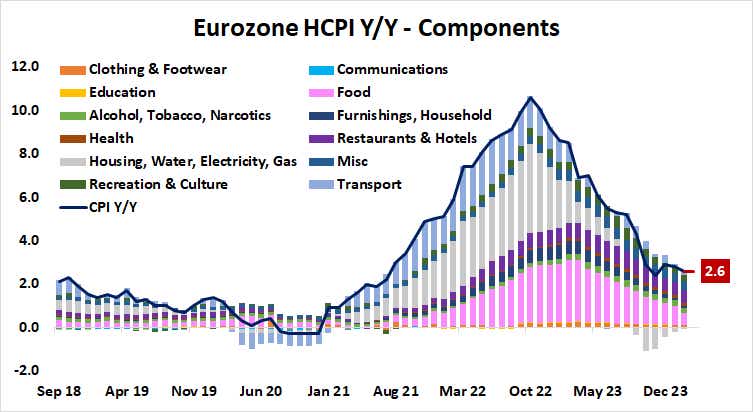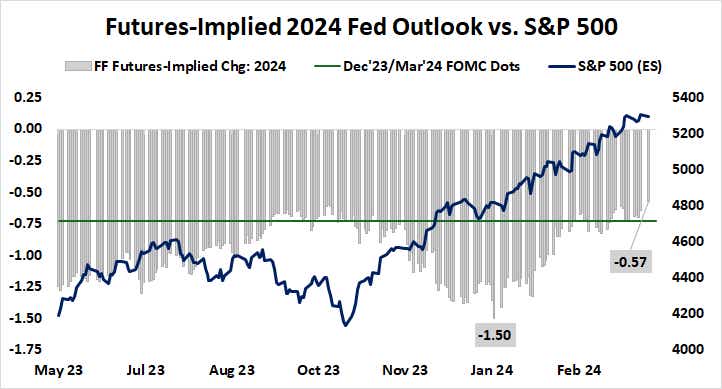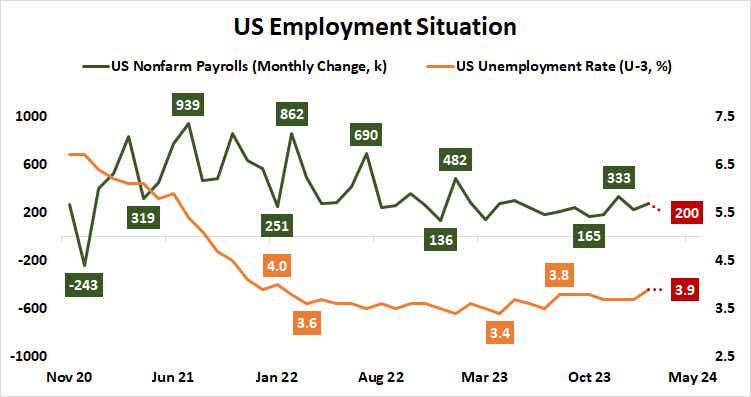Strong U.S. Economic Data and Hawkish Fed Commentary Threaten the Stock Market

Strong U.S. Economic Data and Hawkish Fed Commentary Threaten the Stock Market
By:Ilya Spivak
Stocks are in trouble if strong U.S. economic data and hawkish comments from Fed Chair Jerome Powell continue to wear down 2024 interest rate cut expectations
- Markets now see just two Fed rate cuts in 2024 after Powell comments and the release of ISM data.
- Stocks may decline if upbeat U.S. data flow continues to push back stimulus bets.
- The euro may fall if the Eurozone CPI report brings forward ECB rate cut expectations.
Wall Street woke up with a start from its holiday slumber over Easter weekend, startled by news unveiled while exchanges closed for Good Friday (as expected).
The personal consumption expenditure (PCE) measure of U.S. inflation registered squarely in line with expectations at 2.5% year-on-year for the headline reading and 2.8% for the core measure excluding food and energy. A speech from Federal Reserve Chair Jerome Powell was spicier than traders might have liked, however.
The central bank chief pushed back on rate cut speculation, saying that the impressively resilient economic performance in the U.S. affords officials the chance to be a little more confident on the path of inflation before reducing borrowing costs. “We don’t need to be in a hurry,” he said.
Another bit of better-than-expected economic data helped to reinforce the message. A survey of manufacturing performance from the Institute of Supply Management (ISM) showed that sector unexpectedly returned to growth last month for the first time since October 2022.
In response, Fed Funds futures moved to price in 57 basis points (bps) in rate cuts in 2024. This means the markets now price in two 25bps reductions and a mere 28% probability of a third. That puts investors on the hawkish side of policy officials, who penciled in three cuts into official forecasts just two weeks ago.
The prospect of more expensive credit than the official baseline spooked risk appetite. Stocks fell, with the bellwether S&P 500 down 0.25%. Treasury bonds shifted to reflect higher rates across the yield curve. The benchmark 10-year rate jumped 10.7bps to a two-week high. The U.S. dollar added 0.5% against an average of its major peers.
Here are the macro waypoints likely to shape price action in the week ahead.
Eurozone consumer price index (CPI) data
Eurozone inflation is expected to have held steady at 2.6% year-on-year in March, unchanged from the prior month. The core rate excluding volatile food and energy prices is marked for a decline, however, down to a two-year low of 3%.
Baseline forecasts for German numbers due to cross the wires a day ahead of the region-wide report are likewise tilted to the downside. CPI harmonized to the use the same methodology as the European Central Bank (ECB) – a more policy-relevant measure than domestic calculations – is expected to slip to 2.4%, the lowest since November 2023.
Analytics from Citigroup reveal economic data outcomes from the single-currency bloc have soured somewhat relative to forecasts over recent weeks. If that sets the stage for downside surprises on incoming CPI releases, the growing likelihood of an ECB rate cut as soon as this month is likely to punish the euro.

Federal Reserve Chair Jerome Powell speech
The head of the U.S. central bank is due to discus the outlook for the economy at the Stanford Business, Government and Society Forum this week. His remarks will come alongside the March service-sector ISM survey as well as an estimate of private sector jobs growth from HR management giant Automatic Data Processing (ADP).
The headline ISM print is seen coming in at 52.6, putting the pace of services activity growth in line with February’s result as well as the 12-month average. Meanwhile, a rise of 148,000 in private payrolls would mark a three-month high.
Stock markets may wobble if Powell continues to play down scope for near term stimulus while the data outcomes extend the recent run of better-than-expected U.S. economic news. The U.S. dollar may likewise extend its broad-based recovery against the major currencies.

U.S. employment data
The March edition of the much-anticipated official set of U.S. labor market figures is expected to deliver an increase of 200,000 in nonfarm payrolls—a narrow climb down from February’s 275,000while the jobless rate holds steady at 3.9%. Average hourly earnings are seen growing 4.1% year-on-year, the lowest since June 2021.
The latter number may be the most market-moving in the data set. Ensuring that wage inflation continues to be squeezed lower is essential to the Fed’s fight to bring price growth back to the target 2%. If stronger-than-expected economic outcomes continue to echo in unexpectedly sticky price pressure, the likely rate cut tally will diminish further.

Ilya Spivak, tastylive head of global macro, has 15 years of experience in trading strategy, and he specializes in identifying thematic moves in currencies, commodities, interest rates and equities. He hosts Macro Money and co-hosts Overtime, Monday-Thursday. @Ilyaspivak
For live daily programming, market news and commentary, visit tastylive or the YouTube channels tastylive (for options traders), and tastyliveTrending for stocks, futures, forex & macro.
Trade with a better broker, open a tastytrade account today. tastylive, Inc. and tastytrade, Inc. are separate but affiliated companies.
Options involve risk and are not suitable for all investors. Please read Characteristics and Risks of Standardized Options before deciding to invest in options.
tastylive content is created, produced, and provided solely by tastylive, Inc. (“tastylive”) and is for informational and educational purposes only. It is not, nor is it intended to be, trading or investment advice or a recommendation that any security, futures contract, digital asset, other product, transaction, or investment strategy is suitable for any person. Trading securities, futures products, and digital assets involve risk and may result in a loss greater than the original amount invested. tastylive, through its content, financial programming or otherwise, does not provide investment or financial advice or make investment recommendations. Investment information provided may not be appropriate for all investors and is provided without respect to individual investor financial sophistication, financial situation, investing time horizon or risk tolerance. tastylive is not in the business of transacting securities trades, nor does it direct client commodity accounts or give commodity trading advice tailored to any particular client’s situation or investment objectives. Supporting documentation for any claims (including claims made on behalf of options programs), comparisons, statistics, or other technical data, if applicable, will be supplied upon request. tastylive is not a licensed financial adviser, registered investment adviser, or a registered broker-dealer. Options, futures, and futures options are not suitable for all investors. Prior to trading securities, options, futures, or futures options, please read the applicable risk disclosures, including, but not limited to, the Characteristics and Risks of Standardized Options Disclosure and the Futures and Exchange-Traded Options Risk Disclosure found on tastytrade.com/disclosures.
tastytrade, Inc. ("tastytrade”) is a registered broker-dealer and member of FINRA, NFA, and SIPC. tastytrade was previously known as tastyworks, Inc. (“tastyworks”). tastytrade offers self-directed brokerage accounts to its customers. tastytrade does not give financial or trading advice, nor does it make investment recommendations. You alone are responsible for making your investment and trading decisions and for evaluating the merits and risks associated with the use of tastytrade’s systems, services or products. tastytrade is a wholly-owned subsidiary of tastylive, Inc.
tastytrade has entered into a Marketing Agreement with tastylive (“Marketing Agent”) whereby tastytrade pays compensation to Marketing Agent to recommend tastytrade’s brokerage services. The existence of this Marketing Agreement should not be deemed as an endorsement or recommendation of Marketing Agent by tastytrade. tastytrade and Marketing Agent are separate entities with their own products and services. tastylive is the parent company of tastytrade.
tastyfx, LLC (“tastyfx”) is a Commodity Futures Trading Commission (“CFTC”) registered Retail Foreign Exchange Dealer (RFED) and Introducing Broker (IB) and Forex Dealer Member (FDM) of the National Futures Association (“NFA”) (NFA ID 0509630). Leveraged trading in foreign currency or off-exchange products on margin carries significant risk and may not be suitable for all investors. We advise you to carefully consider whether trading is appropriate for you based on your personal circumstances as you may lose more than you invest.
tastycrypto is provided solely by tasty Software Solutions, LLC. tasty Software Solutions, LLC is a separate but affiliate company of tastylive, Inc. Neither tastylive nor any of its affiliates are responsible for the products or services provided by tasty Software Solutions, LLC. Cryptocurrency trading is not suitable for all investors due to the number of risks involved. The value of any cryptocurrency, including digital assets pegged to fiat currency, commodities, or any other asset, may go to zero.
© copyright 2013 - 2025 tastylive, Inc. All Rights Reserved. Applicable portions of the Terms of Use on tastylive.com apply. Reproduction, adaptation, distribution, public display, exhibition for profit, or storage in any electronic storage media in whole or in part is prohibited under penalty of law, provided that you may download tastylive’s podcasts as necessary to view for personal use. tastylive was previously known as tastytrade, Inc. tastylive is a trademark/servicemark owned by tastylive, Inc.